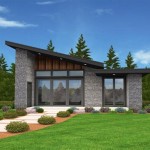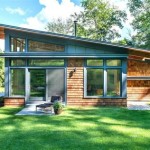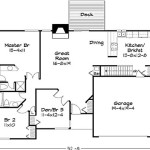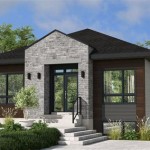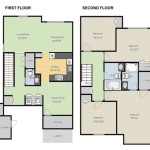Modern Loft Style House Plans: A Comprehensive Guide
Modern loft style house plans represent a sophisticated blend of industrial aesthetics, open space functionality, and contemporary design elements. Originating from the conversion of industrial buildings into residential spaces, the modern loft design ethos has evolved into a distinct architectural style, adaptable to new construction projects. This article provides a comprehensive overview of the key features, considerations, and benefits associated with modern loft style house plans.
The appeal of the modern loft style lies in its inherent flexibility and adaptability. Unlike traditional housing designs that often prioritize compartmentalization, loft style plans emphasize open-concept living, allowing for creative freedom in space utilization. The inherent industrial aesthetic also provides a unique architectural canvas upon which homeowners can layer their personal style and preferences.
Key Characteristics of Modern Loft Style House Plans
Several defining characteristics distinguish modern loft style house plans from other architectural styles. These include open floor plans, exposed structural elements, natural light maximization, and the incorporation of industrial materials.
Open Floor Plans: The defining feature of the loft style is the open floor plan, typically encompassing the living area, dining area, and kitchen into a single, unified space. This design promotes a sense of spaciousness and facilitates social interaction. Walls are minimized, creating visual continuity and allowing natural light to permeate the entire living area. The open layout also permits for dynamic rearrangement of furniture and décor, catering to evolving lifestyle needs. The absence of partitions is generally restricted to main living areas, while bedrooms and bathrooms are typically enclosed for privacy.
Exposed Structural Elements: A hallmark of the loft style is the deliberate exposure of structural elements that would typically be concealed in conventional construction. This includes exposed brick walls, concrete floors, and visible ductwork, pipes, and beams. These elements serve as both functional components and visual accents, contributing to the industrial aesthetic. Exposed brick walls, for example, provide a textural contrast to smoother surfaces, while exposed ductwork adds a raw, utilitarian touch. The treatment of these elements is crucial; they should be cleaned, sealed, and sometimes painted to achieve the desired aesthetic while ensuring durability and safety.
Natural Light Maximization: Optimizing natural light is a crucial aspect of modern loft style design. Large windows are strategically placed to capture sunlight throughout the day, illuminating the open living space and enhancing the feeling of spaciousness. Skylights are also frequently incorporated to introduce additional light from above, particularly in areas where windows are limited. The use of light-colored walls and reflective surfaces further amplifies the effect of natural light, creating a bright and airy atmosphere. Window treatments are typically minimalist, such as simple blinds or sheer curtains, to avoid obstructing the flow of light.
Industrial Material Palette: The material palette used in modern loft style house plans typically reflects its industrial origins. Common materials include concrete, steel, brick, wood, and glass. Concrete is frequently used for flooring and countertops, providing a durable and visually striking surface. Steel is incorporated in structural elements, railings, and furniture, adding a touch of industrial strength. Reclaimed wood is often used for flooring, wall cladding, and furniture, injecting warmth and character into the space. Glass is used extensively for windows, doors, and partitions, maximizing natural light and maintaining visual continuity. The combination of these materials creates a balanced aesthetic that is both rugged and refined.
Planning Considerations for Modern Loft Style House Plans
Developing a modern loft style house plan requires careful consideration of several factors to ensure functionality, comfort, and aesthetic coherence. These considerations include zoning regulations, structural integrity, soundproofing, and climate control.
Zoning Regulations and Building Codes: Before embarking on a modern loft style construction project, it is imperative to thoroughly research and understand local zoning regulations and building codes. These regulations dictate permissible land use, building height, setback requirements, and other parameters that can impact the design and construction of the house. Building codes specify minimum standards for structural safety, fire resistance, and accessibility. It is crucial to ensure that the proposed design complies with all applicable regulations and codes to avoid costly delays and potential legal issues. Obtaining the necessary permits and inspections is also essential to ensure the project's legitimacy and safety.
Structural Integrity and Reinforcement: Given the emphasis on open space and exposed structural elements, ensuring structural integrity is paramount in modern loft style house plans. The removal of interior walls can compromise the stability of the building if not properly addressed. Consult with a structural engineer to assess the load-bearing capacity of the existing structure and to design appropriate reinforcement measures. This may involve adding steel beams, columns, or other structural supports to maintain the integrity of the building. Careful planning and execution are essential to prevent structural problems and ensure the long-term safety of the house.
Soundproofing Considerations: The open floor plan of a loft style house can amplify sound transmission, potentially creating noise issues. Implementing effective soundproofing measures is crucial to minimize noise pollution and enhance privacy. This can involve installing soundproof windows and doors, insulating walls and ceilings with sound-absorbing materials, and using resilient flooring underlayment. Careful consideration should be given to the placement of noise-sensitive areas, such as bedrooms and home offices, away from high-traffic areas. Acoustic panels and other sound-absorbing elements can also be incorporated into the décor to further reduce noise levels and improve the overall acoustic environment.
Climate Control and Energy Efficiency: Maintaining comfortable temperatures and minimizing energy consumption are essential considerations in modern loft style house plans. Large windows and open spaces can contribute to heat loss in the winter and heat gain in the summer, increasing energy bills. Implementing energy-efficient design strategies is crucial to mitigate these effects. This can involve installing high-performance windows and doors, insulating walls and ceilings with energy-efficient materials, and using energy-efficient heating and cooling systems. Passive solar design principles can also be incorporated to maximize solar heat gain in the winter and minimize solar heat gain in the summer. The use of smart home technology can further optimize energy consumption by automatically adjusting lighting, temperature, and appliance settings based on occupancy and environmental conditions.
Advantages of Modern Loft Style House Plans
Modern loft style house plans offer several advantages that appeal to homeowners seeking a unique and flexible living space. These advantages include aesthetic appeal, flexible space utilization, potential for value appreciation, and suitability for urban environments.
Distinct Aesthetic Appeal: The industrial-chic aesthetic of modern loft style house plans is a major draw for many homeowners. The combination of exposed structural elements, raw materials, and open space creates a visually striking and unique living environment. This aesthetic appeals to individuals who appreciate minimalist design, industrial heritage, and a sense of urban sophistication. The loft style provides a blank canvas for personal expression, allowing homeowners to create a space that reflects their individual style and preferences. The inherent character of the loft style can also enhance the resale value of the property.
Flexibility in Space Utilization: The open floor plan of a loft style house provides unparalleled flexibility in space utilization. The absence of fixed walls allows for dynamic arrangement of furniture and décor, catering to evolving lifestyle needs. The open space can be easily adapted to accommodate different activities, such as entertaining guests, working from home, or pursuing hobbies. The flexibility of the loft style is particularly appealing to individuals who value adaptability and versatility in their living space. The open plan also promotes social interaction and a sense of connection between different areas of the house.
Potential for Value Appreciation: Modern loft style properties often command a premium in the real estate market, particularly in urban areas. The unique aesthetic appeal, flexible space utilization, and historical significance of loft buildings can make them highly desirable to buyers. Investing in a modern loft style house plan can therefore be a sound financial decision, with the potential for significant value appreciation over time. The scarcity of loft properties, particularly in prime locations, can further drive up demand and prices. However, it is important to carefully research the local real estate market and consider factors such as location, condition, and amenities before investing in a loft style property.
Suitability for Urban Environments: Modern loft style house plans are particularly well-suited for urban environments. The reuse of existing industrial buildings for residential purposes can contribute to urban revitalization and reduce the environmental impact of new construction. The open floor plan and flexible space utilization of loft style houses can be particularly appealing to urban dwellers who value space efficiency and adaptability. The industrial aesthetic of the loft style also complements the urban landscape, creating a cohesive and harmonious environment. The proximity to amenities, services, and cultural attractions in urban areas further enhances the appeal of loft style living.
The development of modern loft style house plans requires careful planning, attention to detail, and a thorough understanding of the unique characteristics of this architectural style. By considering the key features, planning considerations, and advantages outlined in this article, potential homeowners can make informed decisions and create a modern loft style house that meets their individual needs and preferences.

7 Inspirational Loft Interiors House Plan With Style Homes

Modern Loft Style 3 Bedroom Multi Y House Plan Ulric Home

41 Unique 3d Floor Plan Ideas Engineering Discoveries Tiny House Loft Small Apartment Design Interior

Loft Style Home With A Balcony And Multi Purpose Basement Pinoy House Plans

Modern Loft Style One Y House Plan Pinoy Designs

A Modern Loft With Character Home Designing

Plan 80937pm Stately 2 Bed Contemporary House With Loft Plans

Loft House Design Floor Area 48 Sqm

Perfect For Your Budget 2 Bedroom Modern Loft House Cool Concepts

3d Rendering Interior House Modern Open Living Space With Kitchen Loft Style Duplex Residence Home Decoration Luxury Exterior Design Outdoor Terrace Swimming Pool Iração Do Stock Adobe

